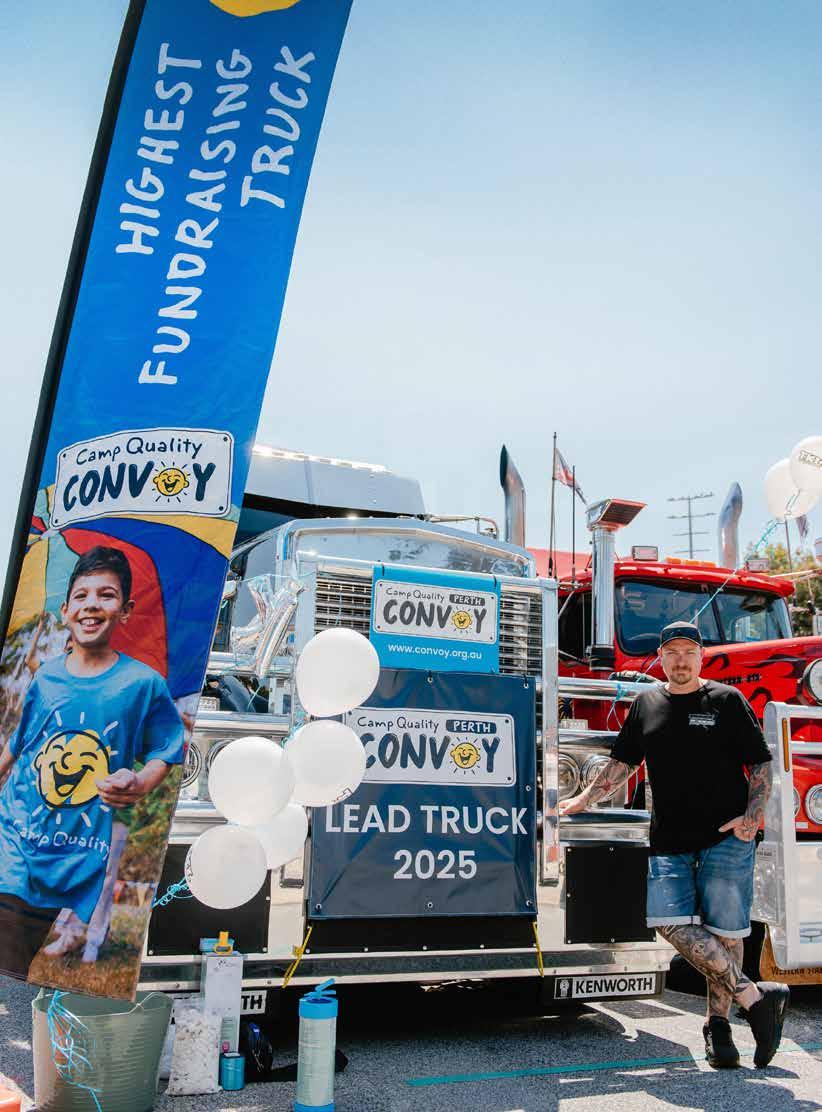


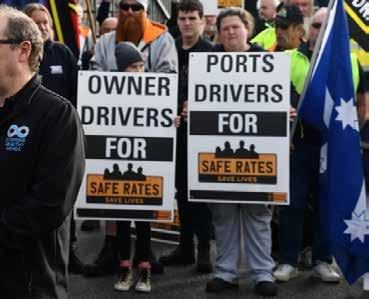
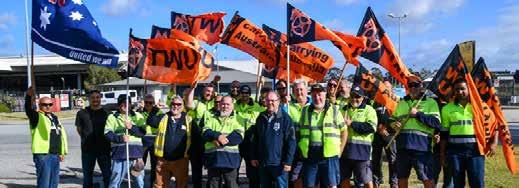










At the TWU, we are relentless in the pursuit of building and exercising worker power, guided by clear, strong principles. We are committed to earning and keeping our members’ trust and bargaining collectively. We aim to hold corporations to account, empowering the workforce with a strong and powerful voice.
The TWU has a number of Enterprise Agreements in a myriad of transport companies. If you work for a company that has an EA with the TWU, you, along with all transport workers benefit from the years of struggle and collective action of union members before you.

And set the standard for transport workers into the future.
TWU Members also benefit from a range of services available only to members
Legal Services
Wage increases and improved conditions through collective bargaining
Enforcement of your agreement and workplace rights
Representation for incidents or disciplinaries
Job Security and protection
$5,000 Funeral benefits
Free Wills
Extraordinary Driver’s License
Income Protection and Group Accident and Sickness cover
Collective purchasing power of UnionShopper to provide members with discounts on a range of restaurants, gift cards, white goods and more
You should be a member of your union, the TWU if you enjoy these benefits like:
Annual Leave
Maternity Leave
Long Service Leave
Sick days
Leave loading
Penalty rates
Superannuation
Health and safety and workers’ compensation
Allowances (meal allowances, shift allowances)
Rest breaks
Unfair dismissal protection
Becoming a member of the TWU ensures you can maintain these rights into the future.
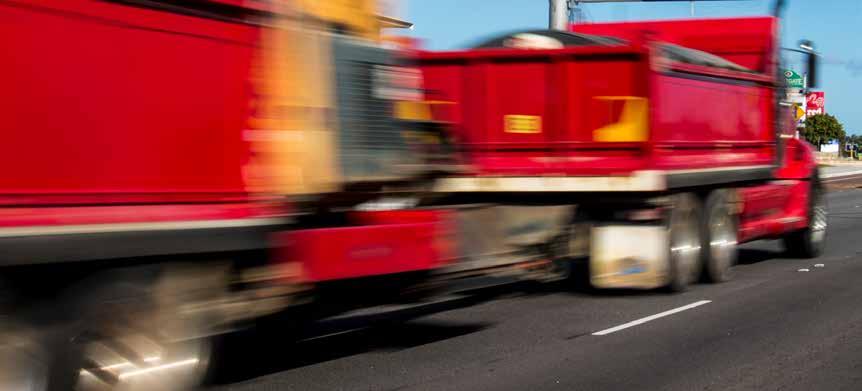
The Heavy Vehicle Helpdesk is open from: 7am to 6pm Monday to Friday, and WA Public Holidays.
On weekends the Main Roads Customer Information Centre will receive telephone calls on behalf of the Heavy Vehicle Helpdesk on 138 HVO (138 486) and email enquiries can be sent to hvs@mainroads.wa.gov.au
Tel: 138 486 Fax: 9475 8455
Email: hvs@mainroads.wa.gov.au www.mainroads.wa.gov.au
Angry Chicken Publishing Pty Ltd
Telephone 0430 153 273 www.angrychicken.com.au
ABN: 35 486 530 095
PUBLISHER / COMMISSIONING EDITOR
Karen-Maree’ Kaye
T: 0430 153 273
Email: karen@angrychicken.com.au
WRITERS
Karen-Maree' Kaye, Russell McKinnon
CONTRIBUTORS
Jan Cooper, Cam Dumesny, Cliff Graham, Carol Messenger, Ray Pratt
ADVERTISING ENQUIRIES
Angry Chicken Head Office
T: 0430 153 273
E: karen@angrychicken.com.au
DESIGN / PREPRESS
Cally Browning | Bare Creative
ACCOUNTS
T: 0430 153 273
E: accounts@angrychicken.com.au
PRINTER Daniels Printing Craftsmen
SUBSCRIPTIONS
Subscriptions available directly from the Publisher.
T: 0430 153 273
E: karen@angrychicken.com.au
Australia: 1 year $130 (inc GST)
Overseas subscribers: Airmail postage will be added to subscription rate.
Editorial Submissions: The Publisher welcomes editorial submissions. Once received they will become the property of the Publisher who reserves the right to edit the or adjust the content to fit with the format of our publication.
West Australian Transport Magazine (WATM) is published by Angry Chicken Publishing Pty Ltd
ABN: 35 486 530 095 All rights reserved. No part of this publication may be reproduced, adapted or transmitted in any form by any process (graphic, electronic, mechanical or storage and retrieval system) or sold, resold or otherwise exploited for any purpose without consent of the Publisher.
The publisher, contributors, editors and consultants disclaim any and all liability and responsibility to any person or party, be they a purchaser, reader, advertiser or consumer of this publication in regards to consequences and outcomes of anything done or omitted, or being in reliance whether partly or solely on the contents of this publication. No person, organization or party should rely on or on any way act upon any part of the contents of this magazine without first obtaining the advice of a fully qualified person. The Publisher shall have no responsibility for any action or omission by contributor, consultant, editor or related party for content within WATM. The opinions and content within WATM does not necessarily reflect those of the Publisher, editor or their agents. No responsibility is accepted for damage or loss of material supplied to the publisher.

nd we have a wrap on 2025 as it flashed past at record speed. A merry Christmas to all WA Transport readers, supporters and contributors and I wish you all the best for 2026.
In last months edition Ray Pratt, our columnist of Fair Go for the Owner Driver wrote - The Great Northern Disgrace –when a Highways lets the industry down –talking about his recent run along the Great Northern Highway from Perth to Wubin and what he thought of the roads… Well did that get everyone talking as the story crossed over the transport industry into the general population and readers pointed out a plethora of roads in Western Australia that they deemed unsafe. This article got
so many people talking it got to the ears of Mr Shane Love MLA who will be tabling a petition in parliament about the state of the Great Northern Highway.
Congratulations to Camp Quality’s Convoy Perth and all the participants – you should all be extremely proud of yourselves for your achievements and what a good look it is for the transport industry to be such a massive fund raiser for these deserving kids and their families.
As always, thank you to everyone who supports the magazine. You are appreciated.
Best,


Under the leadership of Cam Dumesny
CEO of Western Roads Federation (WRF), WA, SA, NT and Australian Government agencies joined operators recently for a briefing on this summer’s weather forecast and the actions being taken to reduce freight disruption.
Western Australia's long and tenuous freight route connections are increasingly vulnerable to disruption, as shown over recent years.
“Taking inspiration from the WA Department of Fire and Emergency Services’ highly effective internal state resupply group, Western Roads Federation has expanded on the concept to include SA and NT as we really rely heavily on them for alternative routes to the Kimberley and increased combination capacity when required,” Cam Dumesny said.
The briefing included updates by multiple agencies, with observers from some east coast state governments and Australian Government agencies including Defence.
“While we prepare for disruptions, other parts of the Australian Government are considering lowering default speed limits where signs are absent,” Cam said.
“This impacts some secondary cross border freight routes; therefore, the priority should be making roads safer and more resilient,” he said.
Meanwhile, Transport and Logistics businesses are urged to stay storm savvy
as Australia’s official cyclone and storm season begins and are being encouraged to ready their operations and update their emergency response plans to best prepare for what’s ahead.
The severe weather season runs from November to April, with an average of three to four cyclones crossing the Australian coast each summer, as well as storms and associated flooding.
NTI CEO Janelle Greene said storms, heavy rain, and flooding can have a significant impact especially on transport and logistics businesses.
“Severe weather events can cut key transport links, significantly disrupt the movements of cargo, and damage equipment, vehicles, and properties,” Ms Greene said.
“Equipping yourself with an action plan ahead of time, communicating that plan across the business, and checking weather warning systems is essential for the safety of people and keeping your business running during this period, and after.
“While businesses might be well-versed in the risks that come with cyclone and storm season, it pays to avoid becoming complacent.”
All businesses are urged to consider how they will keep their business running during and after a severe weather event.
“Consider creating a Business Continuity Plan or review yours if you already have one. Ensure it is up to date,

that it covers risks specific to the business, potential impacts and response plans, and that it’s been shared with all staff.”
Other tips for business preparations include:
• Practising evacuation drills.
• Making copies of important documents and backing up critical data.
• Updating and distributing emergency contact numbers, including local emergency services.
• Preparing evacuation kits, including torches, food, water, and first aid equipment.
• Photographing equipment as evidence of pre-event condition.
• Removing loose materials from your property, safely storing machinery, relocating equipment to above known flood levels, and if necessary, sandbagging your property.
NTI’s dedicated weather page and resources, including Guide to Developing a BCP, and Flood Mitigation Guide can be found at www.nti.com.au/industry/severeweather
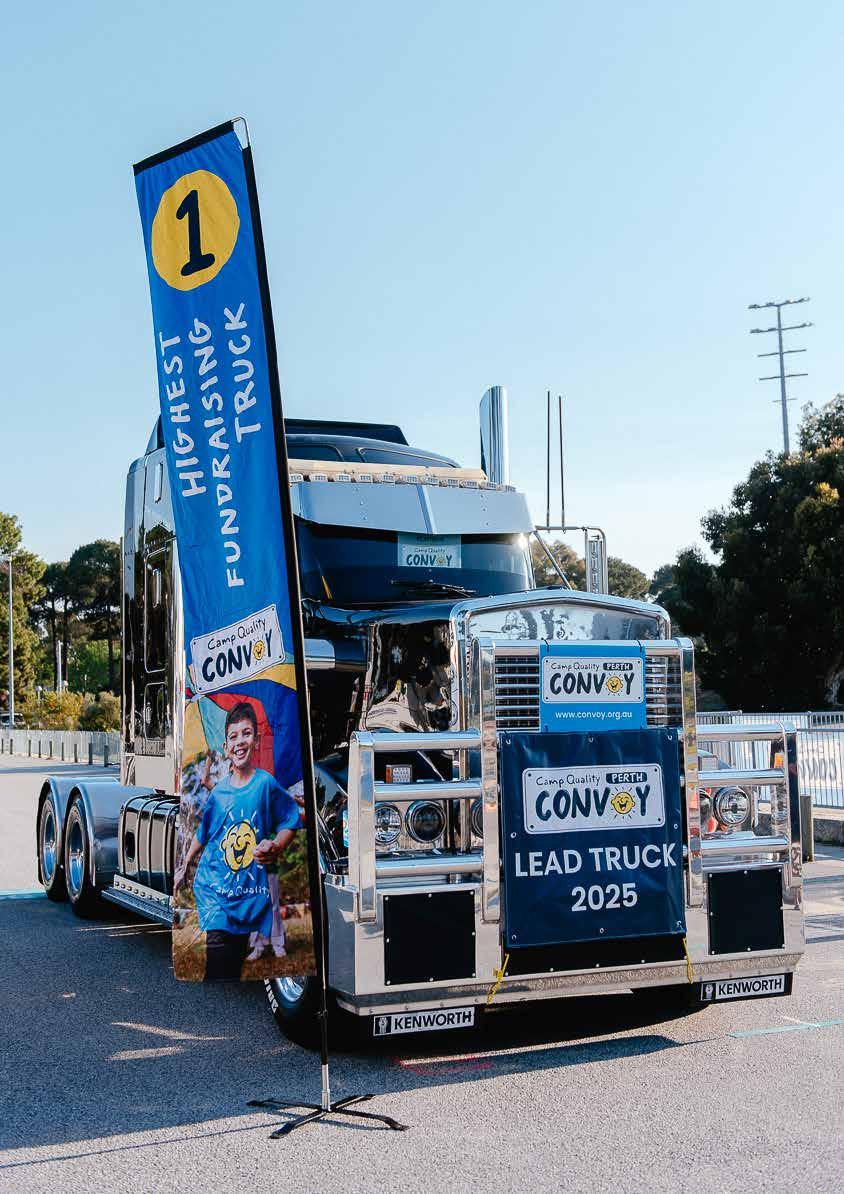


Western Australian truckies have been applauded for their record-breaking efforts to support kids facing cancer at Camp Quality’s Convoy Perth 2025.
On 12 October, 220 trucks took part, driving a 40km loop around Perth, beginning and ending at Perth Hockey Stadium, taking in Bentley, Welshpool, Morley, Osborne Park, and the city.
More than 1,000 people attended the Convoy Perth Family Festival to check out the prime movers in close-up - all of which were polished to the max and looking their absolute best. Hundreds more spectators lined the roadside to cheer on the drivers as the trucks passed by.
Truckies left the fundraising target of $400K in the dust, with the final tally hitting an awesome $421,657.
That amount surpassed Convoy Perth 2024 which raised over $400K, and exceeded its target of $350K, also
Korey Lee, who headed up the Convoy in Lead Truck No. 1 raised a hefty $49.2K alone, with Dan Ross (Lead Truck No. 2) not far behind at $39.5K and Team Harper (Lead Truck No. 3) raising $21.7K

establishing a new record.
“For the third year in a row, Convoy Perth has smashed the fundraising target, now raising more than $1m across the three events,” said Camp Quality’s Chief Commercial Officer Sandie Hall. She also thanked Convoy Perth 2025’s Platinum Sponsor, Baaz Heavy Towing for their support, sponsorship and generosity.
“The funds raised will allow Camp Quality to support families across Western Australia impacted by cancer, through our hospital programs, camps, Family Fun Days, Family Retreats and Cancer Education Program,” Sandie said.
Korey Lee, who headed up the Convoy in Lead Truck No. 1 raised a hefty $49.2K alone, with Dan Ross (Lead Truck No. 2) not far behind at $39.5K and Team Harper (Lead Truck No. 3) raising $21.7K.
TKL Logistics took the honours as Highest Fundraising Corporate Team hauling in a whopping $75.1K, with Team



Kalynda getting the gong for Highest Fundraising Community Team for raising $40.8K.
Best Presented Fleet went to Sands Fridge Lines, with Ross Cunningham taking home the guernsey for Best Presented Truck and Gnalla Enviro picking up the Kids’ Choice Award.
“All of the truckies put in so much effort to immaculately present their trucks for the event. Some had decorated their trucks with Camp Quality logos, or had local primary schools provide artwork for their trucks,” Sandie Hall said.
“We also had historic, vintage trucks and trucks themed after famous characters like Wolverine. It was an incredibly diverse group, and our participants loved them all.”
However, ultimately, it's about the kids and their families that Camp Quality supports. Four years ago, Harper, now 10, was diagnosed with a brain tumour and understandably her family were devastated. Following 11 hours off surgery and followup treatment at Perth Children’s Hospital, Harper is thankfully now in remission,
TKL Logistics took the honours as Highest Fundraising Corporate Team hauling in a whopping $75.1K, with Team Kalynda getting the gong for Highest Fundraising Community Team for raising $40.8K

Harper’s family is just one of more than 800 registered for Camp Quality’s services and programs in WA. Camp Quality provides in-hospital support for kids undergoing cancer treatment as well as opportunities for kids to have fun on Family and Kids Camps and Family Fun Days with other kids and parents who understand what they are going through.
“The camp was very exciting,” Harper enthusiastically told Channel 9 News, riding high in the cabin of one of the participating trucks, making Convoy Perth 2025 an experience she will never forget.
“Camp Quality has done a lot for our family over the four years,” Harper’s Dad, Dominic, said. “You’re with families who have been through the same thing,” he explained. “[Camp Quality] gives you a holiday away from the harsh reality [of cancer].”
Convoy Perth will return in 2026! To find out how you can get involved, visit the https://fundraise.campquality.org.au/ convoy and express your interest.


The State Government is calling for submissions to a review of Western Australia's workplace health and safety laws.
The Work Health and Safety Act 2020 (WHS Act) must undergo a review process every five years, with a report being tabled in Parliament once the review is completed.
The purpose of the review is to gather feedback to identify areas of improvement and ensure the WHS Act is operating as intended.
The new laws came into effect in 2022 and aim to protect the health, safety and welfare of all workers at work.
Submissions can be made by 28 November at https://safetyline.wa.gov.au/ consultations/work-health-and-safety-act2020-statutory-review/
Industrial Relations Minister Simone
TMcGurk said, "It is important that WA's work health and safety laws reflect a contemporary, harmonised approach to protecting the health and safety of people at work.
"As a government, we are committed to the strongest workplace safety standards.
WorkSafe Commissioner Sally Northsaid, “This statutory review provides an opportunity for stakeholders and the community in general to submit comment on the effectiveness of the Work Health and Safety Act since it came into operation in 2022.
"I encourage anyone with an interest in the safety and health of WA workers to consider the questions posed in the discussion paper and submit their comments."
he Australian Trucking Association (ATA) has lobbied multiple Australian Government ministers to progress a broad policy agenda across themes of safety, workforce, productivity and sustainability.
ATA CEO Mathew Munro said constructive engagement across multiple ministerial portfolios was the only way to make meaningful progress.
“We know that improving heavy vehicle productivity via infrastructure upgrades and improved road access is an immediate and cost-effective way to reduce carbon emissions. These issues cut across at least three ministerial portfolios,” Mathew said.
“Similarly, resolving our workforce shortages will require improved skill recognition and classification, access to training support, driver licensing reform and new skilled migration pathways. Again, no single minister or level of government is responsible for all these issues.
“By working in cooperation with all
the responsible ministers, the ATA hopes to promote a more successful integrated approach to the many complex and multi-faceted issues facing the trucking industry,” he said.
The ATA met with:
• Minister for Infrastructure, Transport, Regional Development and Local Government Catherine King
• Minister for Skills and Training Andrew Giles
• Minister for Home Affairs Tony Burke
• Assistant Treasurer Dr Daniel Mulino
• Assistant Minister for Climate Change and Energy Josh Wilson, and
• Assistant Minister for Productivity and Competition Dr Andrew Leigh.
Mathew said the meetings were an opportunity to articulate the role of trucking in a more prosperous Australia.
The State Government has introduced new labelling requirements for electric, hybrid, and hydrogen vehicles in Western Australia.
As of 1 January 2026, owners of electric, hybrid, or hydrogen vehicles manufactured or modified on or after 1 January 2019 are required to display the EV or H labels on the front and rear number plates on their vehicle.
The blue EV triangle labels or yellow H pentagon labels alert emergency services to follow safety procedures when attending a crash or incident involving one of those vehicles.
Owners will be given a 12-month transition period until 1 January 2027 to affix the labels, with non-compliant vehicle owners risking fines of up to $800.
While owners of vehicles manufactured or modified prior to 1 January 2019 are not required to comply with the new law, they are strongly encouraged to do so.
Vehicle owners will be required to purchase and suitably attach EV or H labels to their vehicle licence plates ensuring any characters on the number plates are not obscured.
A label will also need to be fitted to rear auxiliary plates if used by the owner of the vehicle.
For more information on the new requirements, visit www.transport. wa.gov.au/evlabels
Minister Assisting the Transport Minister Jessica Stojkovski said, "I welcome the new EV and H label requirement as an important safety measure to protect our emergency services personnel.
"The labels enable our first responders to identify electric, hybrid, or hydrogen vehicles quickly and ensure they take the necessary safety precautions when attending a crash scene or other incident.
"This change brings WA into line with the Australian Light Vehicle Standards Rules and other Australian jurisdictions regarding this requirement."
The State Government is taking the next step in securing Western Australia's container trade future, releasing the tender to progress planning for key freight rail upgrades and the removal of the North Lake Road level crossing in South Lake.
These upgrades are a critical component to the Westport Program that will ultimately shift container trade from Fremantle to a new, modern facility in Kwinana.
The Request for Proposals invites companies to form an integrated project team to undertake the definition phase.
Works being planned and developed include new freight rail connections into the future Kwinana container port, duplication of freight rail between
Kwinana and Cockburn, including removing existing rail level crossings, and replacing the existing North Lake Road rail level crossing in South Lake with a new bridge.
The project definition phase will include developing reference designs, community and stakeholder engagement, geotechnical and environmental site investigations, and progressing regulatory approvals to enable construction to proceed once funding is allocated.
Planning for a new container port at Kwinana is being jointly funded by the Albanese and Cook Labor Governments.
The Request for Proposals (RFP) is now open, with contract award anticipated in the first half of 2026.
WA Transport Minister Rita Saffioti





said, "We know rail is the safest and most efficient way to transport containers, and these upgrades are essential to increasing our container-on-rail mode share considerably once the new port container terminal opens.
“Our aim is to move more containers off our roads and onto rail, making our entire container supply chain safer and more efficient.
“This work will also be a game changer for local communities by removing bottlenecks like the North Lake Road level crossing, making it safer and less congested.
“Westport will futureproof WA's trade capabilities for the next century, ensuring costs for imports, exports, and everyday goods remain low”




From major truck workshops, heavy haulage, cranes, the mining industry and more… our team of knowledgeable and qualified technicians share over 100 years combined experience and focus on delivering prompt service alongside the supply of top name brakes and clutchesthroughout Australia and Asia.
With over 20 years in the industry we have a well-earned reputation for the development, manufacture and supply of quality standard and customised designs to suit a wide range of applications.
For the best advice and friendly service contact us today.
+61 8 9353 4411 ■ sales@knightbrakeandclutch.com.au knightbrakeandclutch.com.au

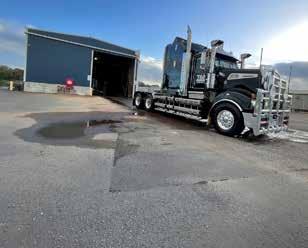


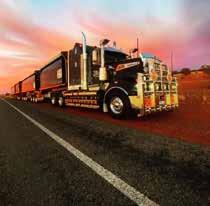


Following its successful launch in September 2024, Main Roads Transport Inspectors began using a state-of-the-art mobile application which supports realtime heavy vehicle analytics.
Main Roads partnered with the National Heavy Vehicle Regulator (NHVR) and Motorola to develop the Regulatory Compliance Mobility Solution WA (RCMS WA) app.
RCMS WA enables Main Roads to target high risk offenders, access a central database in real time with driver and vehicle information, and administer digital and hard copy notices during a heavy vehicle intercept.
By leveraging heavy vehicle compliance and enforcement data, Main Roads can focus on recidivist offenders to keep road users safe and prevent damage to infrastructure.
Following the introduction of RCMS WA, Main Roads collaborates with the NHVR in real time and is alerted to unsafe, high-risk operators travelling between WA and the Eastern States, and vice versa. Under this enforcement approach the Transport Inspectors prioritise unsafe drivers, operators and vehicles.
The RCMS WA app provides a single central system to store and analyse compliance and enforcement data in real time.
The RCMS WA app also connects with over 115 fixed cameras located across Australia, providing Transport Inspectors with immediate alerts on vehicles flagged for non-compliance, supporting swift identification of unregistered vehicles, compliance breaches, and defect notices.
By leveraging heavy vehicle compliance and enforcement data, Main Roads can focus on recidivist offenders to keep road users safe and prevent damage to infrastructure
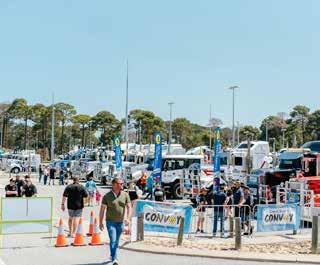
The third annual Perth Camp Quality Convoy for Kids was held on 12 October, raising money and awareness for children with cancer, with help from Main Roads. The convoy departed Perth Hockey Stadium at Curtin University and travelled 50 kms around Perth on a set route before returning to Perth Hockey Stadium for more fun and activities for all.
The organisers exceeded last year’s impressive effort with over $412,000 raised and 200 vehicles participating in 2025.
A Main Roads Traffic Escort Warden escorted the convoy safely through Perth and helped to ensure an enjoyable and highly visible event for all participants.
The Road Network Operations Centre (RNOC) played a pivotal role on the day, managing the traffic control signals and ensuring a smooth and safe passage for the convoy.
Congratulations again to the organisers of the event on a terrific outcome.
Enhancements to the RAV Mapping Tool
We made significant enhancements to the RAV Mapping Tool, aimed at improving user experience and accessibility for the transport industry.
The enhanced RAV Mapping Tool offers a comprehensive and easy-to-use map that includes:
• Approved Networks
• Heavy Vehicle Travel Impacts
• Restricted Structures Lists
• Drive Over & Under Structure Locations
• WA Agricultural Pilot Zones, Road Train Assembly Area locations and more
These enhancements provided users with quick access to crucial information, streamlining operations and improving efficiency.
We have also updated the RAV Mapping Tool to make it more user friendly for mobile device users and to maximise screen space displaying the map itself. The main menu is hidden by default when the user launches the Tool, and the user can open and close the menu as desired.
Introduction of the Heavy Vehicle Assessment Tools (HVAT)
We have continued working with the National Transport Research Organisation (NTRO) to develop a suite of assessment
tools to assist road managers and transport operators in better understanding the performance of heavy vehicles and their impacts.
We commenced working with NTRO in 2024 with the launch of the Restricted Access Vehicle Route Assessment Tools (RAVRAT), which provided users with the RAV Grades Calculator, ESA Calculator, and the Intersection Acceleration Risk Calculator. With the addition of the new assessment tools, the RAVRAT has been renamed to the Heavy Vehicle Assessment Tools (HVAT) to better represent the available suite of assessment tools.
HVAT includes the following assessment tools:

As we head closer and closer to the end of the year, it’s timely to remind industry of the upcoming Christmas and New Year curfew periods.
The Christmas and New Year Curfews are published in the Single Trip OSOM Vehicle Standard Operating Conditions at www.mainroads.wa.gov.au/4aa48d/ globalassets/heavy-vehicles/permits-ordersschemes/osom/single-trip-osom-vehiclestandard-operating-conditions.pdf and the Class 1 RAV Oversize Period Permit Operating Conditions at www.mainroads. wa.gov.au/4ab1df/globalassets/heavy-vehicles/ permits-orders-schemes/osom/class-1-ravoversize-period-permit-operating-conditions.pdf
The curfews are as follows:
1) RAVs exceeding 2.7 metres in width and/
The SRT Calculator enables the static rollover threshold to be estimated for a heavy vehicle to assist the user in understanding and effectively managing rollover risks.
The Trailer Clearance Calculator assists users in ensuring their vehicle combination complies with trailer gap clearance requirements, so no part of adjoining vehicles will collide.
RAV Grades Calculator
The RAV Grades Calculator assists users in determining the maximum grade
or 30 metres in length must not travel on Forrest Highway and Lakelands Lake Clifton Road (this includes the Mandurah and Dawesville Bypasses), between the intersections of Pinjarra Road and Peppermint Grove Road, during the period from sunset on 18 December 2025 until sunrise on 4 January 2026.
2) RAVs exceeding 4.5 metres in width and/ or 30 metres in length must not travel on any of the following roads during the periods from sunset on 23 December 2025 until sunrise on 27 December 2025, and from sunset on 30 December 2025 until sunrise on 4 January 2026: (a) Albany Highway (Bedfordale Road Train Assembly Area, to Albany);
(b) Brand Highway; (c) Eyre Highway;
(d) Great Eastern Highway;
(e) South Western Highway (Armadale to Bunbury);
(f) Great Northern Highway (Roe Highway to Mt Magnet).
3) RAVs exceeding 5.5 metres in width and/ or 40 metres in length, must not travel on any road in Western Australia during the period from sunset on 18 December 2025 until sunrise on 4 January 2026. Operators are to ensure they plan their movements with sufficient time margins to accommodate any unforeseen delays, as Traffic Escort Services will not allow Oversize vehicles to proceed beyond this curfew time.
a vehicle can safely traverse, or the minimum mass required on the drive axles to safely traverse a specified grade.
The ESA Calculator enables the user to determine the pavement wear caused by specific heavy vehicles and how different heavy vehicles compare against each other in terms of their impact on different sealed road surfaces.
The Intersection Acceleration Risk Calculator enables the user to compare the acceleration performance and
clearance times of different heavy vehicle combinations through a specific intersection.
HVS will continue to work with NTRO to expand the suite of assessment tools to enable users to make more informed decisions and help improve heavy vehicle safety on the public road network.
A link to the HVAT is available on the Access Requirements in WA at www.mainroads.wa.gov.au/heavyvehicles/access-requirements-in-wa/ and the Permits, Orders and Schemes at www.mainroads.wa.gov.au/heavyvehicles/permit-order-scheme/
Over to you

After decades behind the wheel, thousands of Australian truck drivers, particularly owner-drivers, are reaching retirement age with little Superannuation, declining health, and few safety nets to fall back on.
Industry groups say it’s an issue that has been quietly growing for years, but only now coming into sharper focus as an ageing workforce begins to step away from the job. Trucking is a career built on hard miles, not financial security.
Owner-drivers operate under a business model that leaves little room for long-term planning.
Rising fuel costs, insurance premiums, maintenance bills and tight margins mean Superannuation contributions are often skipped. One breakdown or major repair can wipe out months of income. For many, Super becomes optional because survival isn’t.
This pattern, repeated year after year, means drivers approach retirement with far less Super than workers in other industries. Some rely solely on the aged pension. Others continue working well into their late sixties and seventies-not by choice, but by necessity.
Long hours, poor sleep, limited exercise and the constant pressure of deadlines have long been linked to poor health outcomes in transport. Drivers commonly report chronic pain, heart problems and fatigue-related conditions-ailments that often worsen with age. Many long-distance drivers keep going because they simply have no alternative.
“You don’t realise what the job has done to you until you stop,” says one
retired driver. “Your body is worn out from years of vibration, lifting, sitting and stress. By the time you can retire, you’re too tired to enjoy it.”
For many, the combination of poor health and limited savings makes retirement feel less like a well-earned break and more like an uncertain final chapter.
Australia’s Superannuation system is largely built around employer contributions- something owner-drivers don’t receive. While the self-employed can contribute voluntarily, advisers say the system assumes people have enough spare income to do so.
“The model doesn’t reflect the volatility of trucking,” explains one industry consultant. “Drivers can have one good year followed by a bad one. Margins are so fine that one major breakdown can derail everything. Super just isn’t built for unpredictable incomes.”
Calls for reform have surfaced repeatedly. Proposals include tailored contribution schemes for contractors, tax incentives for low-margin operators, and retirement planning programs for younger drivers entering the industry.
Despite the challenges, truck drivers remain the backbone of Australia’s supply chain. Yet many feel overlooked once they hang up the keys.
“People see trucks every day but never think about the person inside,” one driver says. “When we retire, it’s like we disappear.”
He recalls his own turning point: “I stopped driving at sixty. I still owned my truck and trailer and had plenty of work, but all I was doing was paying bills. Each year it got harder to survive. I took a job in the mines as a fly-in fly-out worker. The money and conditions were great, and for once we had money in the bank. After ten years I retired at seventy, much better off than if I’d stayed on the road. That job paid Super and I could salary sacrifice and it made a huge difference. Many owner-drivers have done the same, not because they want to, but because they have no choice.”
Industry bodies argue that more visibility, and more concrete support, is needed. Without change, they warn, the next generation of drivers will face the same struggles.
“We need to see change if we want to keep our current drivers. I’ve seen too many retire without even owning their own home. It’s not much reward after decades on the road.
As pressure on supply chains continues to grow, unions and industry groups are renewing their calls for better protections, including health programs, financial education, and Super options that reflect the realities of self-employment. Progress, however, remains slow.
For now, many of Australia’s longserving drivers are left to navigate retirement with the same grit that kept them going through their working years.
Truck drivers spend a lifetime delivering for Australia, it’s only fair they get a little more in return.
Keep it safe, Ray Pratt.



he Department of Infrastructure, Transport, Regional Development, Communication, Sports and the Arts has released a Consultation Regulatory Impact Assessment (RIA) on reducing the default speed limit outside of built-up areas.
To say the proposals have sparked spirited debate is an understatement.
Submissions closed on the 10th November and hopefully many of you had your say. It’s important to remember this is a consultation process and there is a long way to go before final decisions are made.
Broadly, the RIA asks us to consider the following options for reducing the sealed-road default from 100 km/h and introducing a new national default for unsealed roads. Several different options for both sealed and unsealed roads are discussed as per table 1.
Our association is concerned that this proposal is a distraction from actions that would make a tangible difference to road safety such as improving road conditions.
Our members drive on nearly every road in WA over a 12-month period from national
highways to tracks into remote stations, in addition to many rural roads in other states, so they are in a good position to comment about the state of our roads. As most people in the transport industry know, many of our roads are in serious need of upgrade and repair which requires large expenditure, so it is useful to divert attention away from that alarming reality, with a proposal to reduce default speed limits.
The RIA acknowledges that there are other options to achieve road safety outcomes. The proposal to reduce default speed limits is a one dimensional, one size fits all approach and ignores a range of initiatives that could be introduced to address declining road safety outcomes.
Table 1
As the RIA points out between 2000 and 2020, Australia recorded a significant decline in road fatalities. This positive trend has been attributed to factors such as improved vehicle safety features (such as adoption of seatbelts and airbags), investments in road infrastructure and design, and shifts in driver behaviour. This safety result was achieved with the current speed limits (default and otherwise) in place, so we would be better investing in an examination of what caused this decline in this 20-year period compared to the current day.
A reduction in the default speed limits outside built up areas would have a significant impact on our members. To put the WA rural freight task into context it is
worth noting that WA covers approximately one third of Australia’s total landmass (32.9%) covering an area of 2,645,615 square kilometres and by comparison is larger than Western Europe. The distances travelled in delivering freight, particularly into remote regions within WA are significant. A large proportion of that travel is on unsealed roads often with time sensitive freight.
The total road network is around 174,000 kilometres in length. Main Roads WA is responsible for 17,700 kilometres or about 10%. Local Government maintains 127,067 kilometres of roads comprising 87.2% of the WA public road network of which 32.1% is sealed, excluding roads in National Parks and on other land managed by the Department of Biodiversity, Conservation and Attractions. The remaining 67.9% (86,303 kilometres) have a gravel or natural surface.1
It is established that lower speed limits increase travel time over long distances therefore decreasing the default speed limit will result in longer journeys for livestock. Good animal welfare outcomes when animals are being transported depends on them getting to their destination as quickly

as possible. A journey of 500km could potentially take an additional two hours and would increase the complexity of managing time off water limits and weather conditions especially heat. The extra time would also require additional driver rest breaks to be factored in.
An additional risk with the proposal is the effect on driver fatigue and it is our view that this has not been adequately considered. Longer journeys result in an increased fatigue risk. The commercial vehicle industry is heavily regulated as far as fatigue is concerned because of the risk. Why then would the Government opt for a policy that would increase driver fatigue?
The impact on productivity is also potentially significant – time is money. Managing logistics due to the extra time needed to complete journeys will add another burden to business operators. Costs will also increase as a result of requiring more resources to complete the job compared to the status quo. The RIA does not adequately quantify those.
It is noted that local and state governments have the ability to sign roads up to a higher limit. It is likely that there
would be strong advocacy in some areas for this to occur, however this will result in an additional administrative burden on state and local governments and potentially industry associations, as industry endeavours to have speed limits increased following the default decrease.
Finally, the issue of compliance is an important consideration. How will compliance be achieved on the remote unsealed network? How will the impact and compliance be assessed before considering further reductions? The RIA recognises that not all drivers comply fully with default speed limits or adjust their speed proportionally to speed limit changes. A lower speed limit is likely to result in higher non-compliance. From a public policy perspective, introducing rules that are difficult to enforce risks eroding public trust in the rules more generally. This is not a desirable outcome for road safety.
The LRTAWA would prefer to see increased road maintenance, an education campaign that highlights the importance of driving to the conditions and the existence of default speed limits and how they are applied.
1 WA Local Government Association; Report on Local Government Road Assets and Expenditure 2021-22








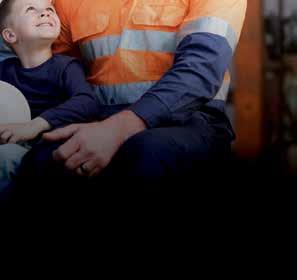




by Cam Dumesny, CEO
On Wednesday 5th November, Senator Glenn Sterle – Labor Senator for Western Australia and Chair of the Senate Rural Regional Affairs and Transport Committee, convened a roundtable to discuss shadow economic activity in the road transport industry and specifically the effect that sham contracting is having on transport companies, productivity and viability. If left unaddressed, shadow economic activity and sham contracting could lead to the demise of the road transport industry in Australia.
The roundtable was attended and represented by every transport association in Australia, the Australian Road Transport Industrial Organisation, Transport Workers Union, employers/business owners, relevant Ministers and Senior Government Department Officials from the Australian Taxation Office, Department of Workplace Relations, Australian Border Force and the Department of Home Affairs.
Background
The road freight industry is experiencing the perpetual rise of ABN-based employment where workers are treated
as contractors, denied basic entitlements, circumventing employee protections and at times PAYG. This illegal activity is not only eroding workers’ rights but destabilising the entire supply chain, creating a two-tier system that favours cost-cutting over safety and fairness.
The widespread use of ABNs to halve labour costs creates an unbalanced market, forcing businesses to either accept unfair terms or risk insolvency. This not only jeopardises the sustainability of the industry but also artificially suppresses wages and safety standards and increases the tax burden on compliant operators.
In summary, we have a supply chain that is under enormous stress with the everincreasing illegal use of ABN’s to halve labour costs and avoid tax and worker entitlements to meet client demands on freight.
The Road Freight industry employs 640,000 Australians and contributes 8.6% to our GDP. Yet, the erosion of the statutory framework if left unaddressed will not only undermine industry stability it will also lead to substantial revenue losses and hamper the capacity to fund essential public services, workers compensation and infrastructure.
• Honourable Catherine King MP - Minister for Infrastructure, Transport, Regional Development and Local Government
• The Honourable Amanda Rishworth MP - Minister for Employment and Workplace Relations
• The Honourable Daniel Mulino MP - Assistant Treasurer
• The Honourable Matt Thistlethwaite MP - Assistant Minister for Immigration
• The Honourable Dr Andrew Leigh MP - Assistant Minister for Productivity, Competition, Charities and Treasury
• Senator Glenn Sterle – Chair of the Senate’s Rural Regional Affairs and Transport Committee, Labor Senator for Western Australia
• Mr Rob Heferen – Commissioner of Taxation, Australian Taxation Office
• Emma Rosenzweig – Deputy Commissioner, Payday Super Program, Australian Taxation Office
• Michael Kaine – National Secretary, Transport Workers Union of Australia
• Peter Anderson – National Secretary of Australian Road Transport Industrial Organisation (ARTIO) & CEO of Victorian Transport Association (VTA)
• Gary Mahon – CEO of Queensland Trucking Association (QTA)
• Michael Mahon – President of Queensland Trucking Association (QTA)
Ill-prepared drivers operating under ABNs outside legislative standards elevate risks and heighten the likelihood of accidents. Australia's ambition is to lead through ‘productivity’ combined with fair and decent working conditions. However, the ‘stability’ of the supply chain is under threat, as its industrial integrity continues to erode.
Review of the ‘Closing the Loopholes Legislation’
It was agreed by participants that the “reasonably believed” defence introduced by the Closing the Loopholes legislation remains dangerously broad - allowing some employers to justify misclassification with minimal proof.
The amendment Bill 2023 replaced subsection 357(2) to provide a defence for an ‘employer’ that allows an argument before a court that the ‘employer’ “reasonably believed that the contract was a contract for services” not just labour.
The Amendment Bill also introduced, subsection 357(3) providing five further elements to the reasonable belief defence creating a loophole in the defences of Part
• Warren Clark – CEO of National Road Transport Association (NatRoad)
• Kellie Boland – Board Member of NatRoad
• Mathew Munro – CEO of Australian Trucking Association (ATA)
• Michelle Harwood – Executive Director of Tasmanian Transport Association (TTA)
• Craig Forsyth – National Vice President of National Road Freighters Association (NRFA)
• Glenn ‘Yogi’ Kendall – Board Member of National Road Freighters Association (NRFA)
• Cam Dumesny – CEO of Western Roads Federation (WRF) & also represented the Northern Territory Road Transport Association (NTRTA)
• Simon O’Hara – CEO of Road Freight NSW (RFNSW)
• Simone Hill – Executive Director of Australian Furniture Removers Association
• Andrew Garrety – Former Chair of Australian Furniture Removers Association
• Paul Ryan – Chair of Transport Education Audit Compliance and Health Organisation (TEACHO)
• Steve Shearer OAM – CEO of the South Australian Road Transport Association (SARTA)
• John West – Managing Director of John West Logistics
9 of the Fair Work Act 2009.
Minister Rishworth noted that a 12-month review of the Closing the Loopholes Amendments would consider all potential improvements to the legislation and encouraged participants to actively contribute to the review process.
A better way to achieve consistency of ‘emploee’ definition across Tax & Fair Work Law – Including a Forward-Looking plan
It was agreed by participants that work on the review of the ‘Closing the Loopholes’ legislation would include the inconsistency of “employee” definition across the Fair Work Act and Tax Law. It is expected a plan would be developed for Ministerial consideration as to how to best resolve this inconsistency.
Improve the effectiveness of the Taxable Payments Annual Report (TPAR)
The ATO outlined to the participant group that road freight industries are required to report through a TPAR where they pay contractors to deliver road freight services. This system was designed to prevent avoidance of tax through cash payments and the under-reporting of income but is
If left unaddressed, shadow economic activity and sham contracting could lead to the demise of the road transport industry in Australia
less effective than it could be.
It was agreed the ATO would review how the TPAR is used to identify and action incorrect registration omitted income, labour expenses and non-lodgement to better ensure those who engage in shadow economy behaviour and deliberately operate outside the tax system are detected by the ATO.
All participants agreed that a National Joint-agency Enforcement and Intelligence Program be undertaken as promptly as can be organised. This program is likely to be undertaken in a series of operations over a 12 month period. Agencies such as Border Force, NHVR, authorised persons of the ATO and the Fair Work Ombudsman, along with State or Australian Federal
Police where necessary would comprise the nucleus of the enforcement team.
The purpose would be to gather critical information on the industrial/tax and migration law abuses to then provide for high profile strike targeting of the sham practitioners.
There was a commitment for the Australian Taxation Office to work with the Department of Home Affairs in identifying income tax anomalies of work-based visa holders in the road freight industry.
These anomalies would identify which individuals or companies would require further investigation.
The roundtable participant group look forward to meeting again in the first quarter of 2026 to discuss the outcomes of enforcement action taken and the progress of the ‘Closing the Loopholes’ review.


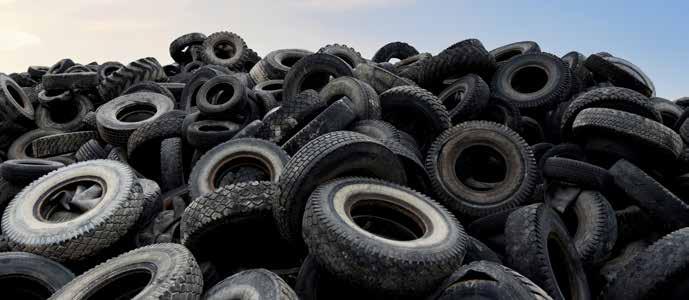
ustralia generates over 67 million end-of-life tyres each year, with many ending up in landfill, stockpiles, or exported without adequate oversight.
The challenges and opportunities arising from used tyres will be the focus of a new inquiry by the House of Representatives Standing Committee on Industry, Innovation and Science.
Improving innovation in the Australian tyre industry presents major opportunities to reinforce domestic manufacturing capabilities and facilitate the development of new markets for recycled materials, contributing to waste reduction and improved resource efficiency.
Committee Chair, Mr Rob Mitchell MP, said, “We want to understand the full lifecycle of a tyre, and how circular economy practices in reuse, retreading and resource recovery can be improved.
A key focus for the Committee will be the development of high-value uses for tyre-derived materials, including tyre designs, recycling processes and alternative materials,’ Mr Mitchell explained.
The inquiry will also consider product stewardship schemes, infrastructure needs, regulatory settings, and environmental and community impacts.
‘We are seeking input from all parts of the sector, from manufacturers and recyclers to researchers and community organisations,’ Mr Mitchell said.
‘This is a critical part of our economy with huge potential for innovation. We want to hear about how the Australian Government can support the tyre industry to become more sustainable into the future.’
Transport industry bodies are calling on the government to move beyond investigation and mandate a mandatory
product stewardship scheme for end-oflife tyres, similar to the successful model already in operation in New Zealand.
"This inquiry is well overdue, but welcome news," said Peter Jones, VACC CEO. "The automotive industry is crying out for a level playing field when it comes to waste tyre management. The status quo simply isn't working for legitimate businesses."
"Rogue operators are placing legitimate businesses at a significant disadvantage, often using deceptive tactics to undercut responsible retailers and collectors. These operators dump tyres illegally, create fire hazards, and damage community environments. This isn't just an environmental issue – it's a competitive fairness issue for law-abiding businesses,” he said.
Industry is calling for a mandatory, co-regulated stewardship scheme that would establish clear responsibility across the tyre lifecycle – from manufacturers and importers through to retailers and consumers. Such a scheme would create a more level playing field and ensure all industry participants meet their environmental obligations.
“Greater penalties for illegal dumping and rogue operators are also needed – a framework with teeth is essential to protect both the environment and legitimate businesses operating responsibly within the industry," Mr Jones said.
The Committee invites written submissions addressing the inquiry terms of reference by Friday 23 January 2026. Further information, including the terms of reference and details on how to make a submission visit www.aph.gov.au/ Parliamentary_Business/Committees/House/ Industry_Innovation_and_Science?
The Fair Work Commission will hold hearings in August 2026 on the TWU’s application for a road transport contractual chain order.
The TWU application includes a proposal for 30 day payment terms. It proposes banning automatic rate reduction clauses and would require yearly rate reviews.
The Road Transport Advisory Group, a consultation body established under the Fair Work Act, has provided advice to the FWC on the proposed order.
The August 2026 hearing dates are set out in an FWC decision published on Monday 3 November. The decision sets out the following timeline for considering the application—
• TWU to file draft order by Friday 21 November 2025
• Responses from interested parties due Tuesday 16 December 2025
• Directions hearing listed for Friday 19 December 2025
• TWU evidence and evidence by other supporting parties due Friday 27 February 2026
• Opposing evidence due Friday 10 July 2026
Hearings to be held from 17-21 August and 24-28 August 2026.
is ‘The Outback’
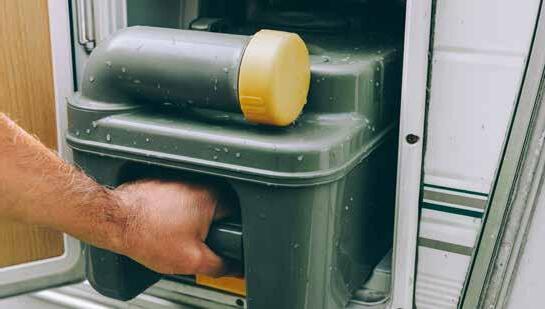
By Cliff Graham
I would like to discuss a conversation I heard on an ABC afternoon radio show regarding caravans and toilet cassette dumping on the Gibb River road.
It has become a biological hazard for truck drivers who must navigate these areas out of necessity and it has become dangerous to walk too far out into the bushes from most parking bays with the fear of stepping in something nasty.
Where is the concern from ‘anyone’ for truck drivers and the health issues, they have no choice in avoiding?
Some common parking spots are experiencing a massive amount of dumping from caravan toilet cassettes. The answers are obvious – caravaners need to be more responsible, and governments and local shires need to install facilities that do not impact other road users for people to properly dispose of their waste.
Another issue is the toilet blocks in parking areas along the highways where it has got to a stage where no road trains can get anywhere close to them because of all the caravans which have their own toilets built into them choosing to conveniently park on the clean bitumen paths surrounding them.
So, it is out into the bushes the truck drivers have to go because they can’t get anywhere near the toilet facilities.
Where is the respect from other road users for truck drivers? On the road, it is obvious that respect for our industry is sadly lacking.
Another issue I am concerned about is the talk of reducing speed limits in rural and outback roads. Who comes up with this stuff?
Surely, the correct answer to road safety is to first ‘fix the roads’
So many roads have not been upgraded and sealed whose main traffic is the trucks that deliver products and essentials to remote areas however, it seems to me, that the driving force behind rural road upgrades is tourism.
Is putting a reduction to the speed limit a way that government departments, whether they are local council or state don’t have the responsibility to maintain the roads to a safe standard?
I’ve driven over plenty of shire roads which haven’t been graded for years.
It makes me question ‘where’ the rates payers funds are going if they are not for services being delivered such as safe road infrastructure.
How arrogantly one sided is this idea of reducing speed limits. Where is

not to mention the damage caused to tyres. This argument has been presented hundreds of times that trucks need to be maintained to be roadworthy state however when it is the state of the roads that is causing the damage to them – crickets.
Again, I ask – where is the duty of care from our governments to keep the road infrastructure in safe working condition? Even the standard of the new bitumen roads I find embarrassing and you see new roadworks having repairs over and over again within months of completion. Yet the regulators are waiting to pounce on trucks and trailers to ensure everything on them complies with the regulation standards.
I will add that many of the transport inspectors in WA are very reasonable. I’ve still been intercepted for inadequate
Is putting a reduction to the speed limit a way that government departments, whether they are local council or state don’t have the responsibility to maintain the roads to a safe standard?
the consideration for animal welfare? It would take many extra hours to travel at the 80km/h suggestion, then these animals, living beings, still have to travel thousands of kilometres to feedlots or their destination once we finally get on the sealed road.
Perhaps someone could explain how are they going to police this?
My own experience with driving on substandard roads has caused many components to crack and break. From radiator mounts to broken springs and
or inappropriate signage on the rear of the vehicle I was driving, a trailer and prime mover yet in the same breath we all drove past abandoned roadworks temporary speed signs laying on the side of the road. Accountability seems dismally one sided. This should be like a tennis game. Transport operators have to have accreditation to operate and the powers to be should offer the same level of quality to their products and services. Yet the ball never seems to be in any government’s court to comply.
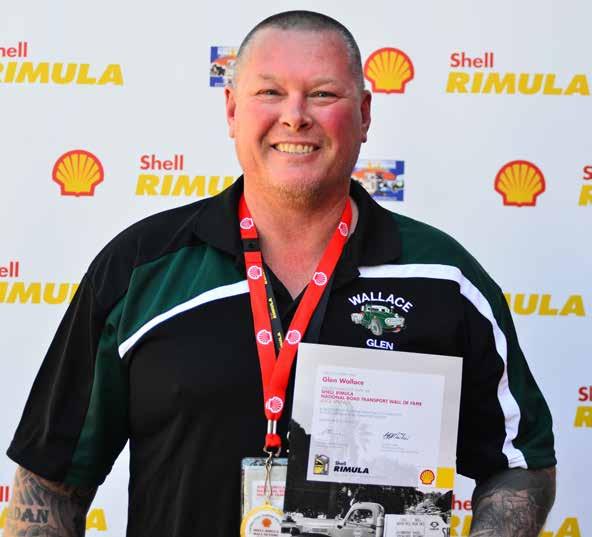
Glen became Logistic Manager for Giacci Bros Transport, overseeing and liaising with the main customers regarding haulage five years
Glen Francis Wallace was born on the 7th November 1967 at Ferntree Gully, Victoria.
Glen started his life in the trucking industry at a young age as his father Frank owned trucks, during these years he was washing, maintaining and learning the basics of running a transport business.
After finishing year 12 in 1985 at Swan Hill Technical School, he went to Mingenew near Geraldton, Western Australia to work on a wheat farm. After coming back to Victoria he drove a semi for his parents company, who contracted for Greenways Transport carrying refrigerated goods all around Victoria, and this included some interstate work.
Greenways were later sold to Cleelands Cold Storage as they did not want contractors with more than one truck. Glen moved on to Melbourne to work
for Tip Top Bakeries for a while, then to Cleelands and drove local for a few years before deciding to join Lake Boga Transport in Footscray, run by Wes Pickering. Glen carted fruit and veggies out of the Victoria Market to country Victoria, sometimes carting salt from Sea Lake to Sydney or Bathurst, then back to Melbourne. He did this for approximately four years.
In 1995 Glen transferred to Kelly & Young in Mildura, a division of Pickering Transport. He drove for a while, and then became the Office Company Representative. In all he spent eight years at this depot.
In April 2004 Glen started as Regional Territory Manager for Armstrong Packaging covering an area of 500 kilometres, preparing budgets etc, until January 2006.
Glen, wife Janene and family lived in Mildura for 10 years before moving to Geraldton, Western Australia in 2006,
where Glen became Logistic Manager for Giacci Bros Transport, overseeing and liaising with the main customers regarding haulage five years.
In November 2010 Glen started with BIS Industries as Operations Manager to set out their Depot in Geraldton. After two years and five months Glen became the Manager of the day to day running of the Nickel-Cobalt Haulage, Logistics, and the workshop business’s at the Murrin Murrin Mine site. In all, one year and eight months until October.
After leaving BIS Glen went on to be the Mid-West Manager for Catalano Transport Pty Ltd working out of Geraldton in October 2014.
Following on from his father Frank, and Grandfather Fred Wallace, Glen has contributed to the Transport Industry for 30 years plus.

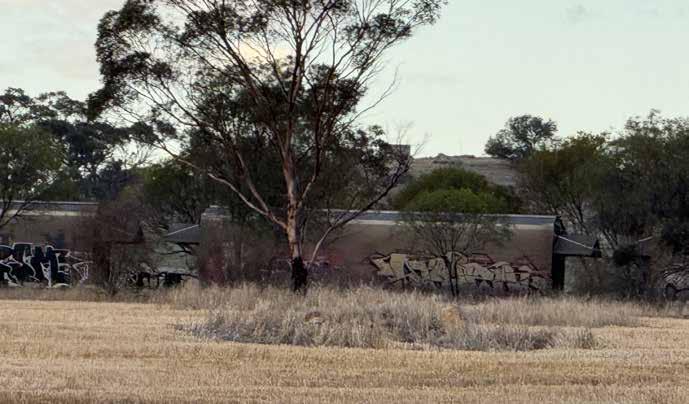
By LARA JENSEN
Exactly 57 years ago in 1968, a hard to track down 109-page report entitled “Railway Level Crossing Protection in WA” was released. Its contents reveal a raft of rail safety recommendations that still haven’t been actioned by the rail industry or legislated by our government almost six decades later.
This reports catalyst was a spate of serious crashes at railway level crossings in WA that led to a review. In it were recommendations on the safety requirements for all level crossings, an outline of the criteria to be used for determining the levels of control required at railway level crossings and a number of specific recommendations to ensure that safety requirements were maintained.
This report is referenced in the Main Roads WA document ‘Railway Crossing Control in WA Policy and Guidelines’ but the specific safety recommendations including beacon lighting for trains and yellow livery colours for rolling stock are not.
On page 7 of the report under 1.12, ‘Associated Safety Measures’ it states, “The Committee considered that the following measures were of sufficient merit to warrant further investigation by the WA Government Railways Commission (W.A.G.R).”
a) Painting yellow of all rolling stock
b) The equipping of all engines and guard vans with rotating beacons.
On page 28, under point 6.6, it says, ”If engines and guards vans are equipped with beacons of adequate brilliance, vehicle drivers would be alerted to a much greater degree than they are at present by the train’s whistle or siren. These beacons should prove especially effective at night.”
The report states, “W.A.G.R should endeavour to paint all rolling stock yellow and maintain this yellow colour by regular washing and painting. If the yellow colour is satisfactorily maintained it will certainly attract driver attention, and by attracting a driver’s attention, the possibility of accident should be greatly reduced.”
Were any of these recommendations introduced? No. 32 years later on a dark rainy night at a notorious level crossing
in the WA Wheatbelt three much loved country people (including my youngest brother) were struck and killed by an inadequately lit grain State Government owned Westrail train loaded with 28 wagons of wheat in July 2000. State Coroner Alastair Hope who presided over the inquest into their deaths said, “The train was not adequately lit and there was no lighting on the train designed to provide an effective warning to motor vehicle drivers at railway crossings' and as such the train 'constituted a very serious hazard indeed.”
He recommended that all locomotives be immediately fitted with external auxiliary lighting yet this urgent safety recommendation was never actioned by the state or federal government.
In 2023, the rail industry’s ‘own’ research again confirmed the value of flashing beacon lights on trains in the Monash Institute of Railway Technology (2023) ‘Assessment of Trials to Improve Train Conspicuousness Approaching Passive Level Crossings’ reinforcing exactly what Coroner Hope found in 2001 and yet we are still no closer to mandatory safety and visibility lighting legislation for trains in WA.
Furthermore, there are still grain trains and their rolling stock operating on the WA rail network that have the same livery (colour scheme) as the sky and the rail line ballast they run on making them camouflaged in agricultural environments. There is also no legal requirement for ‘any’ trains operating on the WA rail network to be lit to any particular standard.
Under the WA Work Health and Safety Act regulations that came into effect in March 2022, a person like me conducting a business on our cattle station has a primary duty of care to ensure the health and safety of our employees, and as part of this primary duty of care I must provide and maintain plant, structure and systems of work that are safe and do not pose health risks.
So, I am at a loss to understand why rail operators undertaking multi-million dollar, high-risk businesses are seemingly exempt from the same duty of care as the rest of us.
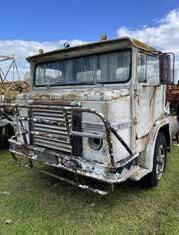

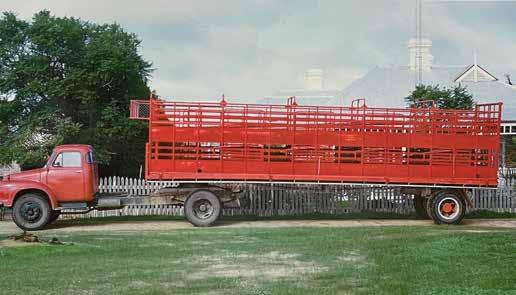

HCVC organised an outing to Kevin and Judy Martins farm at Williams recently. Kevin and Judy have a collection that has been put together over several decades.
The sheds and surroundings are overflowing with tractors, machinery and trucks. It was hard to comprehend how much is actually there. Kevin started buying old machines in the 1970’s and hasn’t stopped.
Kevin and Judy have just built a new shed that occupies about an acre of land
that store the best tractors and old working farm machinery such as headers and seed cleaners indoors. The shed also has a special section set aside for a vintage household items.
Then outside on the hill there is more old trucks, several hundred old crawlers, tractors, ploughs and other towed farm implements. A short trip over the hill reveals the graveyard of old trucks, more tractors and a very large pile of rusty metal with that part you are looking for within it. Then it was onto another three sheds cram
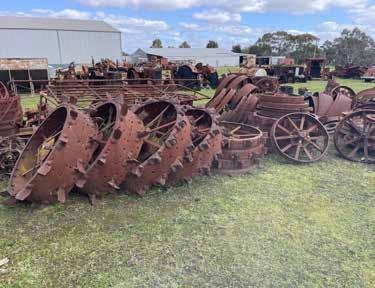
By KEVIN TOOVEY
packed with more tractors and trucks.
One of the features I found was a photo of a red Bedford truck that Kevin bought new in 1960. Kevin then bought a set of second hand Mack hubs and some steel and home built a single axle semi-trailer with a tractor pack welder. Then a Bassula stock crate was bought to fit the trailer, this unit was used for many years. The Bedford was later retired into farm life with a tray back and is still there. Thanks to Kevin and Judy for a great day out and an excellent morning tea.

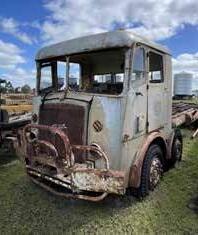




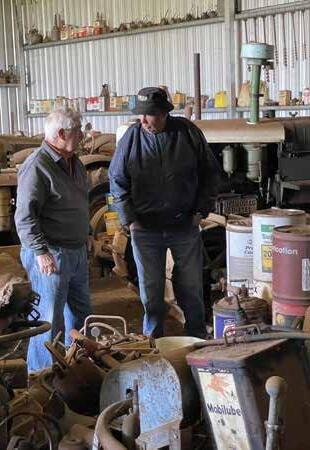

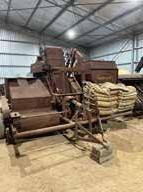


A BOOK BY DONNA VAWDREY

Follow the inspiring and at times devastating journey through Toots Holzheimer’s life. Australia’s most recognised truck driver battling non-existent roads and no telephones from the 1960s to 1990s.
• To purchase Toots’ inspiring book and merchandise visit toots-thebook.com.au •
Intensely proud and vivacious, Toots was not all toughness. She had a soft side to her personality.
Seeing her under a truck covered in grease it may have been hard to imagine her sitting quietly with needle and thread. Toots enjoyed doing embroidery as well as designing and sewing clothes for her family. She made outfits for her children from scratch without a pattern or a tape measure. Pyjamas were one of her specialties, complete with frilly edges and bloomer shorts. Not limited to day-to-day clothing, Toots also made wedding gowns and other outfits for special occasions.
Outwardly tough and more than capable of holding her ground against any man, Toots showed a deep compassion and tenderness towards people. She had a big, generous heart which, combined with her protective instincts, saw her embrace many an abandoned mother and her children. Toots invited them into her own home until they found their feet again, frequently going out of her way to help people, strangers and friends alike.
Toots had an uncanny ability to know when someone was hurting for whatever reason. Station owners came to know the soft side of Toots’ nature and her many kindnesses. A mother of eight children herself, Toots identified with the needs of both mothers and children. An example fondly remembered by many was her habit of going to the Cairns Agricultural Show and buying quantities of show bags filled with treats to give to the kids on her trips north. On other occasions she would surprise the children with lollies or watermelon which was an extra special
treat and dress materials for the mothers who couldn’t drive to Cairns to shop.
Shop owners in Cairns got to know Toots and they nicknamed her the ‘Country Shopper’. Women of the Cape would either give Toots their shopping list or phone the store direct and Toots would pick the goods up at no extra cost and deliver them to their door.
Marrying Ron Holzheimer in 1962 gave Toots the opportunity to pursue the career she had dreamt about since a young girl; a dream to drive trucks. While some may
Marrying Ron Holzheimer in 1962 gave Toots the opportunity to pursue the career she had dreamt about since a young girl; a dream to drive trucks

consider driving trucks to be a hard, lonely way to earn a living, being away from family and friends for days or weeks on end, not so for Toots. She cherished the freedom and the exhilaration of driving through the bush.
With the windows down and the breeze blowing through her hair Toots would sing her favourite songs at full throttle. In her words, ‘I love the adventure. It’s something I don’t gotta do for the sake of doing it. It’s something I wanna do.’
This was the time of the Women’s Liberation movement and although Toots’ chosen lifestyle was a great example for the movement she had no time for these ‘window peekers’ as she called them. She saw them as women who had too much spare time on their hands, who criticised other people instead of getting out and doing a solid day’s work. In Toots’ words, ‘When I get home I’m too buggered to concern myself with what other people are doing or saying.’ Toots believed that life was meant to be lived to the full, with energy and gusto, leaving no time to get bored.
In an almost exclusively male profession this meant keeping up with the men, proving she could handle life on the road, being ‘one of the guys’ without fuss or bother. She didn’t expect to be treated any differently because she was a woman. Nothing made her blood boil quicker than a man telling her what she could or could not do. Attitude was what mattered to Toots, not her gender.
Although she worked in a man’s world, Toots never lost her femininity. In the words of some of her admirers Toots never became ‘a half-baked man’.



The Livestock and Rural Transport Association of Western Australia (Inc) is the only transport association in WA specifically representing rural transporters.
We are a strong voice for rural WA, ensuring that policy decisions support the viability and safety of rural transporters, primary industry and the communities they service.
Members of the Management Committee are hands on business people, most of whom would drive a truck weekly and travel on nearly every road in WA’s 150,000 km road network in the course of a year.
This close proximity between transporting operations and the advisory role means that representatives of the Association are at the coal face and as such are able to provide that all too rare practical hands on advice in committees, consultative forums and meetings.














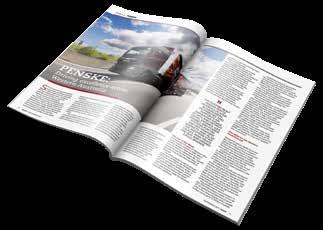
Our digital editions (11 per year) are available at ‘no cost’ and to subscribe please email karen@angrychicken.com.au
You will receive a monthly email from us and be given a link to a high quality Flip Book that you can download and access any links within the publication.
We do not make any profit on our subscriptions. Due to the rising costs of postage and producing the magazine we charge only ‘what it costs us’ to print and post your publication to you.
To receive the hard copies, please email karen@angrychicken.com.au with the following details and you will receive an invoice with EFT details:
Visit www.isubscribe.com.au/wa-transport-magazine-subscription.cfm
Note, this option costs $140 (one year) and the price includes ISUBSCRIBE fees on top of $130 base cost (printing and postage only). Thank you for your understanding and support of an independent publisher who has been producing the WA Transport Magazine for 30 years

